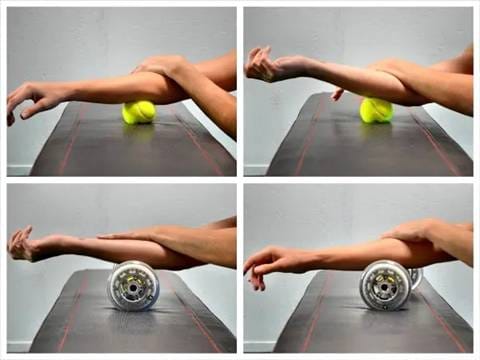Foam rolling is a popular technique known as self-myofascial release, which involves using a cylindrical foam roller to relieve muscle tightness, reduce inflammation, and alleviate soreness. This method can be particularly beneficial for relieving arm pain, whether caused by overuse, poor posture, or exercise-related injuries. By applying pressure to the muscles and fascia (the connective tissue surrounding muscles), foam rolling improves blood circulation and enhances flexibility, making it an excellent tool for recovery and long-term arm health.
Understanding the Benefits of Foam Rolling for Arm Pain Relief
- Relieves Muscle Tension: Foam rolling applies deep pressure to muscle knots or “trigger points” in the arms, which helps release tight fascia and reduce soreness. This process promotes muscle relaxation and can significantly alleviate arm pain.
- Enhances Flexibility and Range of Motion: Foam rolling helps stretch the muscles and improves their flexibility. By increasing the range of motion in your arms, it becomes easier to perform daily tasks and exercise without discomfort.
- Increases Blood Flow: Foam rolling stimulates blood flow to the muscles, which accelerates recovery and aids in reducing inflammation in the affected areas. Improved circulation helps flush out toxins and brings nutrients to the muscles, promoting faster healing.
- Prevents Injury: Regular use of a foam roller can help prevent injuries by loosening up tight muscles, improving flexibility, and maintaining muscle elasticity. This is especially beneficial for athletes or individuals who engage in repetitive arm movements.
- Stress Relief: The rhythmic motion of foam rolling has a calming effect on the nervous system, promoting relaxation. This can help relieve stress-related muscle tension, particularly in the shoulders and upper arms.
How to Use a Foam Roller for Arm Pain
Foam rolling the arms requires proper technique to maximize its benefits and avoid injury. Below are step-by-step instructions on using a foam roller for various parts of the arm:
Foam Rolling the Forearms
- Position: Sit on the floor or a chair and place your foam roller on a table or the floor.
- Movement: Gently press your forearm onto the foam roller and slowly roll from the wrist to just below the elbow. Use your other hand to apply gentle pressure and control the motion.
- Duration: Roll back and forth for about 1-2 minutes, pausing on tight or tender areas for 20-30 seconds to release the tension.
Foam Rolling the Biceps
- Position: Lie face down with the foam roller placed under your upper arm (biceps).
- Movement: Slowly roll your body over the roller, moving from the shoulder to the elbow. You can adjust the pressure by applying more or less of your body weight onto the roller.
- Duration: Roll for 1-2 minutes on each side, stopping at any tender spots for extra attention.
Foam Rolling the Triceps
- Position: Lie on your side with your arm extended out and the foam roller positioned under your triceps.
- Movement: Roll from just below your shoulder to your elbow, applying gentle pressure. You can use your other arm and legs to control the pressure and support your body.
- Duration: Focus on rolling each triceps for 1-2 minutes, pausing on sore areas for 20-30 seconds.
Foam Rolling the Shoulders
- Position: Lie on your side with the foam roller positioned under your shoulder blade or along your side.
- Movement: Roll gently over the foam roller, moving back and forth from your shoulder down to your upper arm. Adjust the intensity based on your comfort level.
- Duration: Spend about 1-2 minutes on each shoulder, ensuring you target any tight spots for relief.
Foam Rolling the Lats (Latissimus Dorsi)
- Position: Lie on your side with your arm extended overhead and the foam roller placed just below your armpit.
- Movement: Slowly roll along the side of your body from just under the armpit to the mid-rib area. Focus on targeting the lats, which play a significant role in upper arm movement.
- Duration: Roll for 1-2 minutes per side, adjusting the intensity based on the level of discomfort.
Frequently Asked Questions (FAQs)
- How often should I foam roll my arms? Foam rolling can be done 3-4 times per week, especially after exercise or when you experience arm tightness or discomfort. Consistency is key for long-term benefits.
- Can foam rolling cause injury? When done correctly, foam rolling is a safe technique. However, avoid rolling over joints, bones, or injured areas, as this can cause further damage. If you feel sharp pain, reduce pressure or stop altogether and consult a healthcare professional.
- How long should I foam roll each muscle group? Focus on each muscle group for 1-2 minutes, pausing on any tender spots for 20-30 seconds. Avoid rolling for too long, as overdoing it can lead to increased soreness.
- Can foam rolling help with chronic arm pain? Yes, foam rolling can help alleviate chronic arm pain by loosening tight muscles and fascia. However, if the pain persists, it’s essential to consult a medical professional to rule out underlying issues.
- Should I foam roll before or after exercise? Foam rolling can be beneficial both before and after exercise. Rolling before a workout helps warm up muscles and improve flexibility, while post-exercise rolling aids in muscle recovery and reduces soreness.
Conclusion
Foam rolling is an effective, low-cost method to relieve arm pain and improve overall muscle health. By incorporating foam rolling into your routine, you can alleviate tightness, enhance flexibility, and promote faster recovery from arm injuries or overuse. Remember to follow proper techniques and listen to your body to avoid injury.





